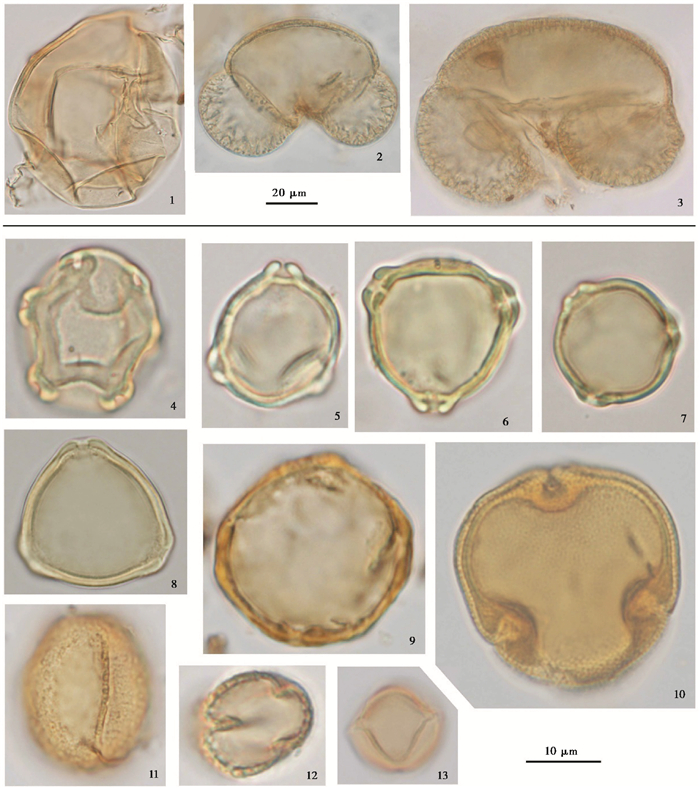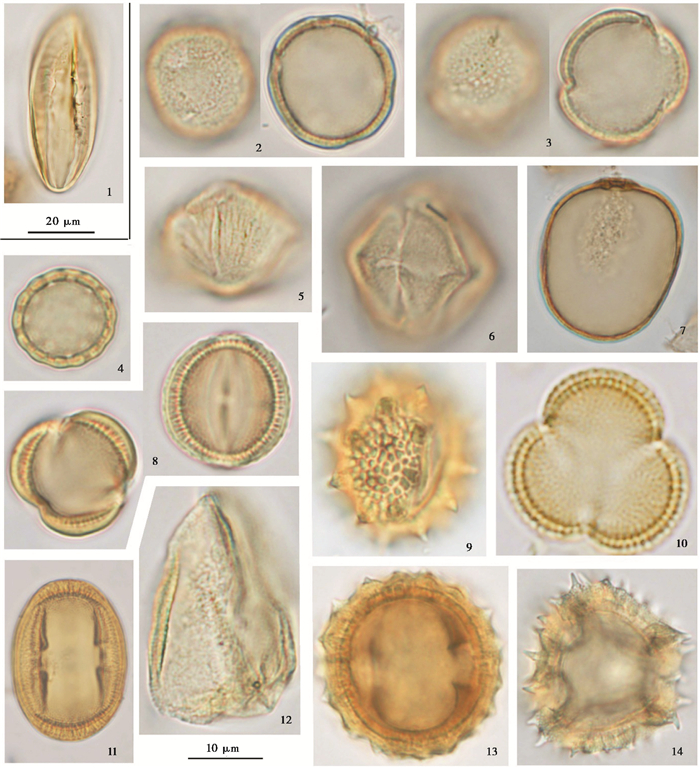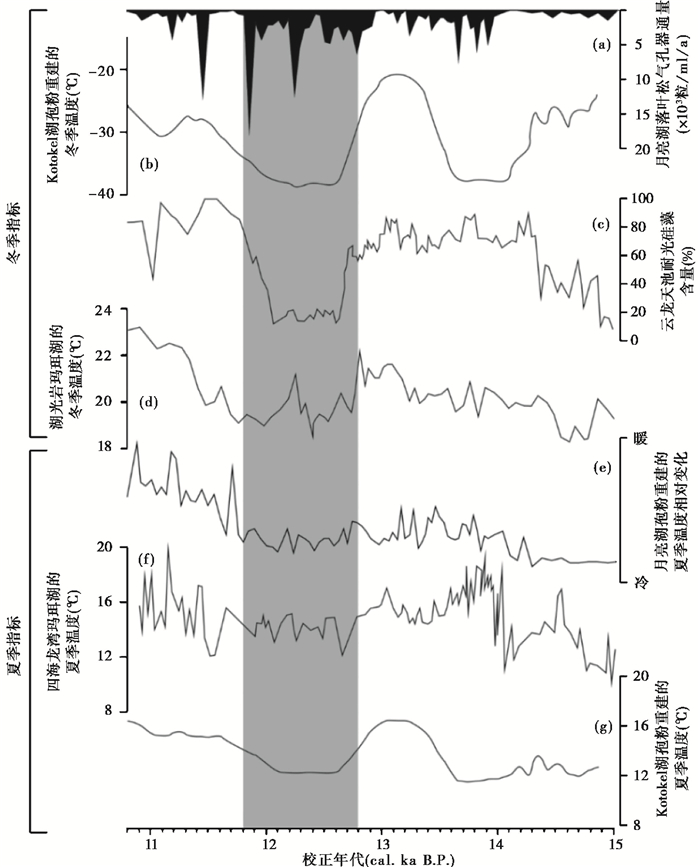2 中国科学院地球科学研究院, 北京 100029;
3 中国科学院南京地质古生物研究所, 江苏 南京 210008;
4 中国科学院大学, 北京 100049;
5 中国科学院生物演化与环境卓越创新中心, 北京 100044)
新仙女木事件(Younger Dryas,简称YD事件)是发生在末次冰消期的一次冷事件,该事件的结束标志着全新世的开始,是研究最多、最为详细的千年尺度上的突变事件[1~6]。YD事件对整个北半球中高纬度地区的气候变化产生了明显的影响,通常情况下,被认为使得生态环境发生了恶化[7]。
在我国现有研究的基础上,YD事件的具体表现仍无法形成统一的认识。例如,我国黄土高原巴谢剖面记录了YD事件期间东亚夏季风的增强[8],与之相反,长江中下游和西南地区的石笋记录显示该事件期间东亚夏季风明显减弱[9~11];西北地区青海湖岩芯记录了YD事件期间气候明显变干,降温并不十分显著[12~13],而在东北地区哈尼泥炭碳同位素记录中该事件的气候特征为冷湿[14~15]以及内蒙古东部呼伦湖的孢粉记录揭示YD期间针叶和落叶阔叶林的扩张[16]。因此,YD事件是否普遍造成了生态环境的恶化尚未明确,而且事件表现形式上的差异,也很难用区域性差异来解释。因此,近年来一些研究逐渐注意到YD事件的季节性特征。如,东北四海龙湾玛珥湖长链烯酮重建的温度显示,YD期间的夏季降温有限[17],云南天才湖摇蚊重建的夏季温度也支持了这一论点[18];而广东湖光岩玛珥湖支链甘油二烷基甘油四醚类化合物重建的冬季温度显示YD期间的冬季降温明显[19],云南云龙天池的硅藻记录揭示YD期间区域冬季降雪明显增加[20]。仅有的几例对YD事件季节性特征研究结果说明,其季节性特征研究仍十分缺乏。综上所述,本文拟在已发表数据的基础上,用大兴安岭中部阿尔山-柴河火山区月亮湖末次冰消期的多指标记录,揭示大兴安岭地区在YD事件期间的植被变化,解释该地区YD事件期间东亚季风变化的季节性特征。
1 研究区概况大兴安岭区域冬季特别严寒,生长季短暂,分布着大片连续多年冻土和季节性冻土。兴安落叶松(Larix sibirica)因其喜光、耐寒的特性,在该区域内广泛分布并且占优势。大兴安岭地区落叶松林的分布呈两个楔形,北部的落叶松林由北向南呈一楔形,从国境的最北部向南延伸至毕拉河和扎敦河流,分布面积逐渐减少;由此向南仅断断续续地分布在主岭上;至乌奴耳和绰尔河流向南又开始逐渐增多,其分布宽度逐渐加大,直到阿尔山-柴河火山区,由北向南呈一倒楔形[21]。
月亮湖(47°30′25″N,120°52′05″E)位于阿尔山-柴河火山区,是一个小型封闭的火山口湖(图 1),水面面积约为0.04 km2,最大水深6.5 m,海拔1190 m。该区域内原生的落叶松林由于受到人类活动和火山活动的影响,常常与白桦(Betula platyphyll)、黑桦(Betula dahurica)、蒙古栎(Quercus mongolicus)和山杨(Populus davidiana)等形成混交林,植被垂直分布不明显[21]。该区域气候呈现出受东亚季风控制的特点,水热同期,降雨集中在夏季,年有效积温在2100 ℃左右,年无霜期90~110天[22]。阿尔山市近30年气温变化的距平变化值显示,冬季温度升高明显,变率为夏季的3倍[23]。

|
图 1 月亮湖所在位置以及东亚季风系统 Fig. 1 Locationof Lake Moon and the system of East Asian Monsoon |
月亮湖钻孔于2007年3月在湖泊中心位置获得,钻孔最下部深886 cm,AMS14C年代测定结果显示岩芯最底部年龄约为20.3 cal. ka B. P.[24]。具体采样方法、岩芯特征和测年结果参见已发表的文章[24]。本文仅就15.0~10.8 ka B. P.(545~731 cm)的气孔器、孢粉、总有机碳含量(TOC)、总氮含量(TN)、全岩有机碳同位素和粒度数据进行讨论。气孔器、孢粉、TOC、TN和有机碳同位素的具体实验方法参照已发表的文献[24~25]。出现频率较高的主要花粉类型见图版 1和图版 2,它们分别是针叶与落叶阔叶植物、草原与草甸植物的花粉。粒度的样品以1 cm间隔进行处理,前处理及分析过程在中国科学院地球环境研究所完成,分析仪器为Malvern Mastersizer 3000激光粒度分析仪,粒径测试范围为0.01~3500 μm。

|
图版 1 主要的针叶与落叶阔叶植物花粉 1.落叶松属Larix,2.松属Pinus,3.云杉属/冷杉属Picea/Abies,4.桤木属Alnus,5,6桦木属Betula,7.鹅耳枥属Carpinus,8.榛属Corylus,9.榆属Ulmus,10.椴树属Tilia,11.栎属Quercus,12.柳属Salix,13.绣线菊属Spiraea Plate 1 Key pollen taxa of conifers and broadleaves |

|
图版 2 主要的草原与草甸植物花粉 1.麻黄属Ephedra,2.唐松草属Thalictrum(上焦面与光切面),3.毛茛科Ranunculaceae(其他类型,上焦面与光切面),4.藜科/苋科Chenopodiaceae/Amaranthaceae,5.委陵菜属Potentilla,6.地榆属Sanguisorba,7.禾本科Poaceae,8.蒿属Artemisia(极面与赤道面),9,13,14.菊科Asteraceae(9,13. Aster type,14. Taraxacum type),10.十字花科Brassicaceae,11.蓼属Polygonum,12.莎草科Cyperaceae Plate 2 Key pollen taxa of steppe and meadow |
研究表明,在12.8~11.8 cal. ka B. P.之间,月亮湖湖泊沉积物中落叶松气孔器的通量较之该阶段前后均有明显的增加[25](图 2a和图 3a)。针叶树的气孔器会发生木质化,从而很好地保存在湖泊或泥炭沉积物中,指示母体植物在当地的生长,其数量变化可以指示母体植物在植被中所占比例的变化[25~28]。因此,新仙女木事件期间,月亮湖湖泊沉积物中落叶松气孔器通量的增加,指示大兴安岭地区的植被中,落叶松林的成分明显增加。最近已发表的孢粉组合揭示了在此时段中,以桦木属为主的落叶阔叶成分减少,以及草本成分的增加(图 2b和2c)[29~30]。综合这两个代用指标来看,大兴安岭地区的植被在新仙女木事件期间,虽然有植被成分的变化,但是并没有发生植被类型的更替;与Bølling-Allerød暖期(B-A暖期)和早全新世相比,只是在森林草原植被中,以落叶松为主的针叶林成分增加,落叶阔叶成分减少,草本成分增加(图 2a~2c)。

|
图 2 15.0~10.8 cal. ka B. P.月亮湖岩芯钻孔的落叶松气孔器通量[25] (a)、落叶阔叶成分花粉含量[29~30] (b)、草本成分花粉含量[29~30] (c)、δ13Corg值[24] (d)、TOC/TN值[24] (e)、TOC含量[24] (f)、粘土含量(g)和砂含量(h) 阴影表示YD事件 Fig. 2 Influxof Larix stomata[25](a), percentage of deciduous broad-leaved pollen[29~30](b), percentage of steppe pollen[29~30](c), δ13Corg[24](d), TOC/TN ratio[24](e), TOC content[24](f), percentage of clay(g) and percentage of sand(h) from sediment core of Lake Moon during 15.0~10.8 cal. ka B. P., and YD event in shadow |

|
图 3 YD事件期间月亮湖的落叶松气孔器通量[25] (a)、Kotokel湖孢粉重建的冬季温度[33] (b)、云龙天池耐光硅藻含量[20] (c)、湖光岩玛珥湖的冬季温度[19] (d)、月亮湖孢粉重建的夏季温度相对变化[30] (e)、四海龙湾玛珥湖的夏季温度[17] (f)和Kotokel湖孢粉重建的夏季温度[33] (g);阴影表示YD事件 Fig. 3 Influxof Larix stomata from Lake Moon[25](a), reconstructed winter temperature based on pollen records from Lake Kotokel[33](b), percentage of low-light-tolerant diatoms from Lake Yunlong[20](c), reconstructed winter temperature from Huguangyan Maar Lake[19](d), reconstructed relative summer temperature based on pollen records from Lake Moon[30](e), reconstructed summer temperature from Sihailongwan Maar Lake[17](f), reconstructed summer temperature based on pollen records from Lake Kotokel[33](g)during YD event(in shadow) |
如果说气孔器和孢粉指标揭示了植被的组成,那么TOC、TOC/TN的比值、δ13Corg以及粒度指标(图 2d~2h)可以为植被盖度的变化提供一些间接证据。从TOC指标来看,月亮湖湖泊沉积物中的含量在YD事件期间明显比B-A暖期高,但是比早全新世稍低。TOC/TN的比值则在新仙女木事件期间明显高于B-A暖期和早全新世。无维管的低等水生植物,如藻类的TOC/TN比值通常在4~10之间,而高等陆生维管植物的TOC/TN比值可达20及以上[31]。因此TOC/TN的高值说明YD事件期间月亮湖沉积物中的有机碳更多地来源于陆源输入[24]。在已发表的论文中,月亮湖δ13Corg值记录在YD事件期间明显偏负的主要原因解释为湖泊沉积物中有机质来源于陆生植物的比例增大[24],陆源物质中C3植物碳同位素更为偏轻,这也间接证实了YD期间的森林扩张。孢粉记录显示落叶阔叶林成分在YD事件期间减少[29~30],而此时的森林扩张就很可能是以落叶松为主针叶林成分增加的结果。而粒度的分析结果显示在12.8~11.8 cal. ka B. P.之间,沉积物中的砂含量明显低于12.8 cal. ka B. P.之前,和11.8 cal. ka B. P.之后相当;但粘土含量较这两个时期明显更高(图 2g~2h)。与黄土剖面粒度通常反映冬季风强度不同,月亮湖是一个小型的封闭火山口湖,其粒度的变化与火山口内汇水区的植被状况和表面流强度息息相关。在YD事件期间湖泊沉积物中细颗粒物质含量增加,粗颗粒减少,显示月亮湖火山口内汇水区的地表,在YD事件期间并没有大面积的裸露。因为,如果地表大面积裸露必然造成月亮湖沉积物中砂含量的增加,而粘土含量降低。综合以上结果,YD事件期间大兴安岭地区森林的覆盖度并没有明显的减少,植被和生态没有明显恶化。这一结果与呼伦湖和四海龙湾钻孔孢粉指标揭示的东北地区YD事件时期植被演化结果相一致[16, 32],即北方针叶树在东北地区的山地普遍存在扩张的现象。
3.2 新仙女木事件的气候特征落叶松林耐寒、耐旱,但是要求在夏季达到一定的生长积温才能生长得茂盛。兴安落叶松结实的丰产和连续2年≥ 10 ℃时的积温大于1880 ℃密切相关,而与降雨量的关系并不密切[34]。另外,5月上旬的连续降水和低温冻害,会直接影响兴安落叶松的散粉和结实[34]。因此,其在YD事件期间的扩张指示这一事件期间大兴安岭地区夏季温度并没有明显降低,夏季风强度减弱有限。在此期间,以月亮湖孢粉记录重建的夏季相对温度变化不明显(图 3e)[30],以及TOC含量没有明显降低,也都是支持夏季风没有明显减弱的证据。
同样地处东北地区的四海龙湾玛珥湖长链烯酮指标重建的温度指示,整个YD期间夏季温度的降幅在1~3 ℃之间[17](图 3f);而西北地区青海湖长链烯酮和云南天才湖摇蚊指标重建的温度均显示,YD期间的夏季温度仅降低了2 ℃左右[13, 18]。这些定量重建的结果也都支持了YD期间我国的夏季温度降幅较小,特别是与格陵兰地区8~10 ℃的降温幅度相比[35~36]。
如果YD期间东亚夏季风减弱不明显,那么冬季风又是如何变化的?落叶松属的植物能够在冬季- 40 ℃的低温严寒中生长,因此落叶松林以及其他耐寒针叶林的扩张常常被认为是冬季极寒的表征[37~38]。月亮湖的气孔器记录和位于长白山区附近的四海龙湾孢粉记录都在YD事件期间记录到了落叶松林的扩张[25, 32],指示了YD期间东北地区山地冬季温度降低,冬季风增强。地处内蒙古东部的呼伦湖[16]、位于贝加尔地区的贝加尔湖[39]和Kotokel湖[33]的孢粉记录都显示YD期间以云杉属为代表的暗针叶林成分和以落叶松属为代表的明针叶林成分同时增加,也支持了冬季温度降低,冬季风增强的观点。
另外,地处热带地区的广东湖光岩玛珥湖温度重建结果显示YD期间冬季降温明显[19](图 3d);位于云南的云龙天池在YD事件期间沉积物中耐光性硅藻比例的大幅增加指示了降雪量的大幅增加[20](图 3c)。这些研究结果都支持了在YD事件期间冬季风增强的观点。而地处贝加尔地区Kotokel湖孢粉记录重建的温度变化显示,YD事件期间,最冷月的温度与现代相比降低了15 ℃以上[33](图 3b),而最暖月温度的降低仅为4 ℃左右[33](图 3g),为YD事件的季节性特征在东亚地区表现为冬季温度大幅下降,冬季风增强提供了重要支持。
4 结论本研究以大兴安岭地区中部的月亮湖为研究对象,对湖泊中心钻孔545~731 cm的沉积物进行了多指标综合研究。之前已发表的年代框架显示该段岩芯的年龄范围为15.0~10.8 ka B. P.,包括B-A暖期、YD事件和早全新世。月亮湖末次冰消期的气孔器和孢粉记录揭示了,大兴安岭地区在YD事件期间植被中落叶阔叶成分减少,而以落叶松为主的北方针叶林成分增加,森林仍十分发育。沉积物中TOC含量在YD事件期间高于B-A暖期,也指示森林的覆盖度没有明显降低;高的TOC/TN比值和偏负的δ13Corg值则显示沉积物中有机碳的来源主要是森林植被的贡献;粒度分析显示YD事件期间沉积物中砂含量很低,而粘土含量高,揭示事件发生期间地表有植被覆盖,没有大面积的地表裸露。
YD期间月亮湖的落叶松气孔器通量增加所指示的大兴安岭地区北方针叶林成分的增加,揭示了冬季温度的大幅降低;而孢粉指标重建的夏季温度相对变化在YD期间并不明显。这与东亚季风区其他定量或半定量重建的冬季和夏季温度记录较为一致,即YD事件期间冬季温度下降明显,而夏季降温幅度有限。
综上所述,大兴安岭地区的植被在YD事件期间没有明显的恶化。以兴安落叶松为主的北方针叶林成分的增加指示了事件发生期间冬季温度大幅下降,东亚冬季风明显增强。
致谢: 感谢审稿专家建设性的修改意见!
| [1] |
Fairbanks R G. A 17, 000-year glacio-eustatic sea level record:Influence of glacial melting rates on the Younger Dryas event and deep-ocean circulation[J]. Nature, 1989, 342(6250): 637. DOI:10.1038/342637a0 |
| [2] |
Dansgaard W, White J W C, Johnsen S J. The abrupt termination of the Younger Dryas climate event[J]. Nature, 1989, 339(6225): 532. DOI:10.1038/339532a0 |
| [3] |
Alley R B. The Younger Dryas cold interval as viewed from central Greenland[J]. Quaternary Science Reviews, 2000, 19(1-5): 213-226. DOI:10.1016/S0277-3791(99)00062-1 |
| [4] |
沈吉, 肖霞云. 2万年来南亚季风演化历史[J]. 第四纪研究, 2018, 38(4): 799-820. Shen Ji, Xiao Xiayun. Evolution of the South Asian monsoon during the last 20 ka recorded in lacustrine sediments from Southwestern China[J]. Quaternary Sciences, 2018, 38(4): 799-820. |
| [5] |
何薇, 汪亘, 王永莉, 等. 四川邛海湖泊沉积物记录的过去30 cal.ka B. P.以来的古气候环境特征[J]. 第四纪研究, 2018, 38(5): 1179-1192. He Wei, Wang Gen, Wang Yongli, et al. Characteristics of climate and environment over the past 30 cal. ka B. P. recorded in lacustrine deposits of the Qionghai Lake, Sichuan Province[J]. Quaternary Sciences, 2018, 38(5): 1179-1192. |
| [6] |
崔梦月, 洪晖, 孙晓双, 等. 福建仙云洞石笋记录的新仙女木突变事件结束时的缓变特征[J]. 第四纪研究, 2018, 38(3): 711-719. Cui Mengyue, Hong Hui, Sun Xiaoshuang, et al. The gradual change characteristics at the end of the Younger Dryas event inferred from a speleothem record from Xianyun cave, Fujian Province[J]. Quaternary Sciences, 2018, 38(3): 711-719. |
| [7] |
Broecker W S, Denton G H, Edwards R L, et al. Putting the Younger Dryas cold event into context[J]. Quaternary Science Reviews, 2010, 29(9-10): 1078-1081. DOI:10.1016/j.quascirev.2010.02.019 |
| [8] |
An Zhisheng, Porter S C, Zhang Weijian, et al. Episode of strengthened summer monsoon climate of Younger Dryas age on the Loess Plateau of Central China[J]. Quaternary Research, 1993, 39(1): 45-54. DOI:10.1006/qres.1993.1005 |
| [9] |
黄俊华, 胡超涌, 周群峰. 湖北清江和尚洞石笋的高分辨率碳氧同位素及古气候研究[J]. 地球科学——中国地质大学学报, 2000, 25(5): 505-509. Huang Junhua, Hu Chaoyong, Zhou Qunfeng. High-resolution carbon and oxygen isotope records from stalagmite and palaeoclimate in Heshangdong Cave, Qingjiang, Hubei Province[J]. Earth Science-Journal of China University of Geosciences, 2000, 25(5): 505-509. |
| [10] |
Dykoski C A, Edwards R L, Cheng H, et al. A high-resolution, absolute-dated Holocene and deglacial Asian monsoon record from Dongge Cave, China[J]. Earth and Planetary Science Letters, 2005, 233(1-2): 71-86. DOI:10.1016/j.epsl.2005.01.036 |
| [11] |
Wang Y J, Cheng H, Edwards R L, et al. A high-resolution absolute-dated Late Pleistocene monsoon record from Hulu Cave, China[J]. Science, 2001, 294(5550): 2345-2348. DOI:10.1126/science.1064618 |
| [12] |
余俊清, Kelts K. 末次冰消期晚期青藏高原东北部气候变化[J]. 第四纪研究, 2002, 22(5): 413-423. Yu Junqing, Kelts K. Climatic change in the northeast Qinghai-Tibet Plateau during the late glacial/Holocene transition[J]. Quaternary Sciences, 2002, 22(5): 413-423. DOI:10.3321/j.issn:1001-7410.2002.05.003 |
| [13] |
Hou J, Huang Y, Zhao J, et al. Large Holocene summer temperature oscillations and impact on the peopling of the northeastern Tibetan Plateau[J]. Geophysical Research Letters, 2016, 43(3): 1323-1330. DOI:10.1002/2015GL067317 |
| [14] |
Hong B, Hong Y T, Lin Q H, et al. Anti-phase oscillation of Asian monsoons during the Younger Dryas period:Evidence from peat cellulose δ13C of Hani, Northeast China[J]. Palaeogeography, Palaeoclimatology, Palaeoecology, 2010, 297(1): 214-222. DOI:10.1016/j.palaeo.2010.08.004 |
| [15] |
Zhou W, Zheng Y, Meyers P A, et al. Postglacial climate-change record in biomarker lipid compositions of the Hani peat sequence, Northeastern China[J]. Earth and Planetary Science Letters, 2010, 294(1-2): 37-46. DOI:10.1016/j.epsl.2010.02.035 |
| [16] |
Zhang S, Xiao J, Xu Q, et al. Differential response of vegetation in Hulun Lake region at the northern margin of Asian summer monsoon to extreme cold events of the last deglaciation[J]. Quaternary Science Reviews, 2018, 190: 57-65. DOI:10.1016/j.quascirev.2018.04.023 |
| [17] |
Sun Q, Chu G, Xie M, et al. Long-chain alkenone-inferred temperatures from the last deglaciation to the Early Holocene recorded by annually laminated sediments of the Maar Lake Sihailongwan, Northeastern China[J]. The Holocene, 2018, 28(7): 1173-1180. DOI:10.1177/0959683618761546 |
| [18] |
Zhang E, Chang J, Shulmeister J, et al. Summer temperature fluctuations in Southwestern China during the end of the LGM and the last deglaciation[J]. Earth and Planetary Science Letters, 2019, 509: 78-87. DOI:10.1016/j.epsl.2018.12.024 |
| [19] |
Chu G, Sun Q, Zhu Q, et al. The role of the Asian winter monsoon in the rapid propagation of abrupt climate changes during the last deglaciation[J]. Quaternary Science Reviews, 2017, 177: 120-129. DOI:10.1016/j.quascirev.2017.10.014 |
| [20] |
Wang L, Jiang W Y, Jiang D B, et al. Prolonged heavy snowfall during the Younger Dryas[J]. Journal of Geophysical Research:Atmospheres, 2018, 123(24): 13748-13762. DOI:10.1029/2018JD029271 |
| [21] |
韩杰, 温瑞勇, 迟占颖. 浅谈大小兴安岭森林植被分布[J]. 内蒙古科技与经济, 2004(16): 111-113. Han Jie, Wen Ruiyong, Chi Zhanying. Distribution of forest vegetation in the Greater Xing'an Mountains[J]. Inner Mongolia Science and Technology and Economy, 2004(16): 111-113. DOI:10.3969/j.issn.1007-6921.2004.16.058 |
| [22] |
张海平, 李凤日, 董利虎, 等. 基于气象因子的白桦天然林单木直径生长模型[J]. 应用生态学报, 2017, 28(6): 1851-1859. Zhang Haiping, Li Fengri, Dong Lihu, et al. Individual tree diameter increment model for natural Betula platyphylla forests based on meteorological factors[J]. Chinese Journal of Applied Ecology, 2017, 28(6): 1851-1859. |
| [23] |
杨忠霞, 范洪刚, 张春玲, 等. 近30年阿尔山地区气候变化趋势分析及对旅游业发展影响[J]. 内蒙古气象, 2007(6): 33-34. Yang Zhongxia, Fan Honggang, Zhang Chunling, et al. Analysis of climate change trends in the Arxan area in the past 30 years and its impact on tourism development[J]. Inner Mongolia Meteorology, 2007(6): 33-34. DOI:10.3969/j.issn.1005-8656.2007.06.015 |
| [24] |
刘强, 李倩, 旺罗, 等. 21 ka B. P.以来大兴安岭中段月亮湖沉积物全岩有机碳同位素组成变化及其古气候意义[J]. 第四纪研究, 2010, 30(6): 1069-1077. Liu Qiang, Li Qian, Wang Luo, et al. Stable carbon isotope record of bulk organic matter from a sediment core at Moon Lake in the middle part of the Daxing'an Mountain Range, Northeast China during the last 21 ka[J]. Quaternary Sciences, 2010, 30(6): 1069-1077. DOI:10.3969/j.issn.1001-7410.2010.06.01 |
| [25] |
伍婧, 刘强, 储国强, 等. 晚冰期大兴安岭植被气候变化的气孔器记录[J]. 科学通报, 2016, 61(36): 77-82. Wu Jing, Liu Qiang, Chu Guoqiang, et al. Vegetation history and climate change recorded by stomata evidence during the Late Glacial in the Great Khingan Mountain region, Northeastern China[J]. Chinese Science Bulletin, 2016, 61(36): 3940-3945. |
| [26] |
Hansen B C S. Conifer stomate analysis as a paleoecological tool:An example from the Hudson Bay Lowlands[J]. Canadian Journal of Botany, 1995, 73(2): 244-252. DOI:10.1139/b95-027 |
| [27] |
Li C, Li Y. Study of modern pollen and stomata from surficial lacustrine sediments from the eastern edge of Tibetan Plateau, China[J]. Review of Palaeobotany and Palynology, 2015, 221: 184-191. DOI:10.1016/j.revpalbo.2015.07.006 |
| [28] |
Shen H D, Li C H, Wan H W, et al. Relationships between vegetation and stomata, and between vegetation and pollen surface soil in Yunnan, Southwest China[J]. Chinese Science Bulletin, 2013, 58(15): 1775-1786. DOI:10.1007/s11434-012-5657-2 |
| [29] |
伍婧, 刘强. 晚冰期以来月亮湖孢粉记录反映的古植被与古气候演化[J]. 地球科学——中国地质大学学报, 2012, 37(5): 947-954. Wu Jing, Liu Qiang. Pollen-recorded vegetation and climate changes from Moon Lake since Late Glacial[J]. Earth Science-Journal of China University of Geosciences, 2012, 37(5): 947-954. |
| [30] |
Wu Jing, Liu Qiang, Wang Luo, et al. , Vegetation and climate change during the last deglaciation in the Great Khingan Mountain, Northeastern China[J]. PLoS ONE, 2016, 11(1): e0146261. DOI:10.1371/journal.pone.0146261 |
| [31] |
Meyers P A, Elisabeth Lallier-vergés. Lacustrine sedimentary organic matter records of Late Quaternary paleoclimates[J]. Journal of Paleolimnology, 1999, 21(3): 345-372. DOI:10.1023/A:1008073732192 |
| [32] |
Stebich M, Mingram J, Han J T, et al. Late Pleistocene spread of(cool-)temperate forests in Northeast China and climate changes synchronous with the North Atlantic region.[J]. Global and Planetary Change, 2009, 65(1): 56-70. |
| [33] |
Tarasov P E, Bezrukova E V, Krivonogov S K. Late glacial and Holocene changes in vegetation cover and climate in southern Siberia derived from a 15 kyr long pollen record from Lake Kotokel[J]. Climate of the Past, 2009, 5(3): 285-295. DOI:10.5194/cp-5-285-2009 |
| [34] |
杨凯, 胡静, 孙宝刚, 等. 兴安落叶松的结实规律及其影响因子[J]. 林业科学, 2008, 44(6): 53-59. Yang Kai, Hu Jing, Sun Baogang, et al. Chronic regularity in bearing fruit of Larix gmelinii and influence factors[J]. Scientia Silvae Sinicae, 2008, 44(6): 53-59. DOI:10.3321/j.issn:1001-7488.2008.06.010 |
| [35] |
Denton G H, Alley R B, Comer G C, et al. The role of seasonality in abrupt climate change[J]. Quaternary Science Reviews, 2005, 24(10-11): 1159-1182. DOI:10.1016/j.quascirev.2004.12.002 |
| [36] |
Buizert C, Gkinis V, Severinghaus J P, et al. Greenland temperature response to climate forcing during the last deglaciation[J]. Science, 2014, 345(6201): 1177-1180. DOI:10.1126/science.1254961 |
| [37] |
Sakai A. Freezing avoidance mechanism of primordial shoots of conifer buds[J]. Plant and Cell Physiology, 1979, 20(7): 1381-1390. DOI:10.1093/oxfordjournals.pcp.a075937 |
| [38] |
Sakai A, Weiser C J. Freezing resistance of trees in North America with reference to tree regions[J]. Ecology, 1973, 54(1): 118-126. DOI:10.2307/1934380 |
| [39] |
Tarasov P, Bezrukova E, Karabanov E, et al. Vegetation and climate dynamics during the Holocene and Eemian interglacials derived from Lake Baikal pollen records[J]. Palaeogeography, Palaeoclimatology, Palaeoecology, 2007, 252(3-4): 440-457. DOI:10.1016/j.palaeo.2007.05.002 |
2 Institutions of Earth Science, Chinese Academy of Sciences, Beijing 100029;
3 Nanjing Institute of Geology and Palaeontology Chinese Academy of Sciences, Nanjing 210008;
4 University of Chinese Academy of Sciences, Beijing 100049;
5 CAS Center for Excellence in Life and Paleoenvironment, Beijing 100044)
Abstract
The Younger Drays event is a cold event that occurred during the last deglaciation, which has a significant impact on climate change in the mid-high latitudes of the Northern Hemisphere. However, under the unified understanding of the cooling in the mid-high latitudes of East Asia, there is still a lack of understanding of its seasonal characteristics. In this paper, the stomata, pollen, total organic carbon, δ13Corg and grain size records from the time interval 15.0~10.8 ka B. P. (corresponding to 545~731 cm depth in the lake sediment core) of the last deglaciation of Lake Moon (47°30'25"N, 120°52'05"E) in the central part of the Great Khingan Mountains area were presented. The results show that the influx of Larix stomata increased, the pollen percentage of deciduous broad-leaved decreased versus steppe increased from 11.8 ka B. P. to 12.8 ka B. P., which reveal that the composition of the boreal coniferous forest in the Greater Khingan Mountains area increased, the forest developed during the Younger Dryas event. Compared to the Bølling-Allerød warming and the Early Holocene, the values of total organic carbon from Lake Moon from 11.8 ka B. P. to 12.8 ka B. P. are medium, the values of δ13Corg are lightest and the values of grain size are finest. These results also support that the environment did not deteriorate during the Younger Dryas event in study area, which imply a moderate summer. The comparison with other records in East Asia shows that the winter temperature decreased, and the East Asian winter monsoon increased significantly during the Younger Drays event. 2019, Vol.39
2019, Vol.39
